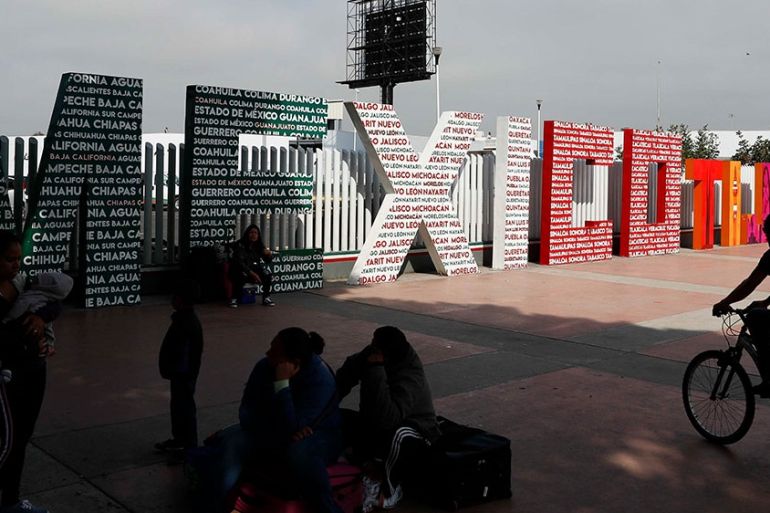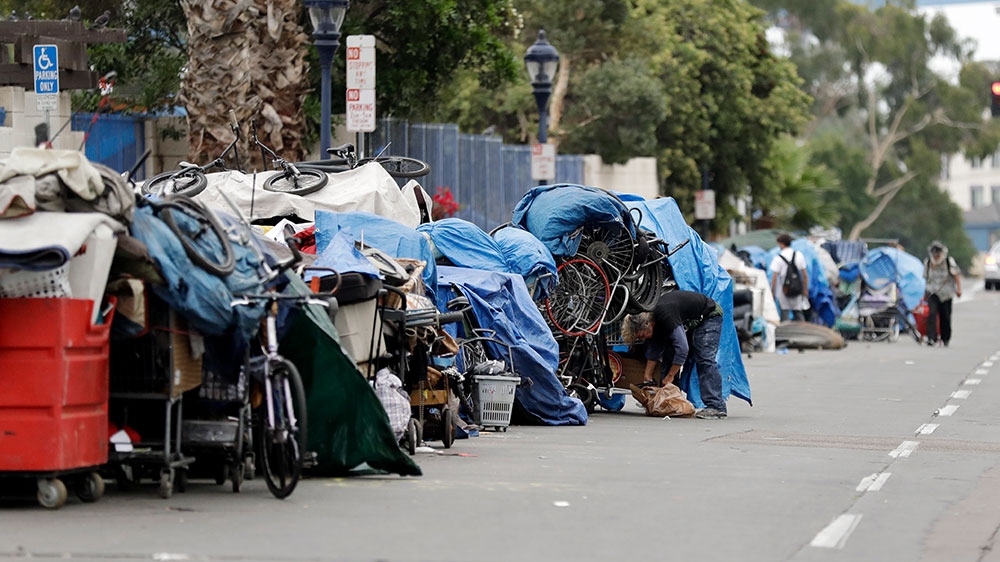The ‘crisis’ driving some Americans to move to Mexico
A lack of affordable housing in the United States is driving many to move across the southern border.

Tijuana, Mexico – When Elizabeth Lucas moved with her four-year-old son from San Diego, California to a dangerous part of Tijuana, Mexico five years ago, she felt she had no other options.
The 32-year-old, originally from Washington state, had been homeless for a year in San Diego before moving about 30km across the border to a $160 a month apartment in Tijuana’s red light district, Zona Norte, an area where drug dealing and violent crime are prevalent. She had spent years travelling back and forth between the United States and Mexico, but over the years has made Tijuana her permanent home.
Keep reading
list of 4 itemsAdvocates gird for Texas migrant law that could upheave US immigration
US appeals court blocks Texas from arresting and deporting migrants
‘Incendiary and wrong’: Biden spurs anger for calling migrant ‘an illegal’
“It was what I had to do,” Lucas told Al Jazeera.
“It was either [move to Tijuana] or be homeless, and now that I have a kid it can’t be like that. I at least have this option … When you’re a girl by yourself on the street, it’s not good,” she said, adding that she feels her family is safer in this part of Tijuana than in parts of San Diego.
Lucas is part of a growing number of US citizens who have moved to Mexico in recent years.
![Tijuana mexico - Americans moving [Anne Bouleanu/Al Jazeera]](/wp-content/uploads/2019/06/55f4edbb7e7a4d4198d0c14bbd2be43d_18.jpeg)
According to 2019 figures from the US Department of State, about 1.5 million US citizens currently live across the US southern border. That figure has more than doubled since Mexico’s 2010 census when the government reported 738,103 Americans resided in Mexico.
The reasons pushing Americans to move across the southern border vary from a finding desirable retirement spot to seeking a different lifestyle, but for many, including Lucas, the high cost of living in the US is becoming simply too much to handle.
‘An affordable living crisis’
Hiram Soto, communications director of the Southern Border Communities Coalition and Alliance San Diego, an organisation that promotes community empowerment along the US-Mexico border, attributes the growth in this trend to a lack of affordable housing options for low-income individuals across California.
“We have a crisis in San Diego, an affordable living crisis, where people can’t afford to buy a home here,” Soto told Al Jazeera. “People take advantage of one of those unique features of the border, which is that you can go to the other side of the town to live more affordably. It’s increased in recent years as affordability has gotten worse, not just San Diego, but across California.”
Although there’s a lack of hard data addressing the number of Americans moving to Mexico moving for purely economic reasons, experts point to high levels of homelessness in California as a possible contributing factor to the influx of Americans heading to Mexico.
San Diego County has the fourth-highest rate of homelessness in the country, with at least 9,000 individuals living either on the street or in shelters, a 2018 report by the US Department of Housing and Urban Development found. The federal agency acknowledges that homelessness rates may be higher than that, as the data did not include individuals who live in vehicles or other makeshift accommodations.

In Los Angeles County, homelessness increased by 12 percent from 2018 to 2019, a study by the Los Angeles Homeless Services Authority found. Nearly 60,000 people in the county are considered homeless.
San Diego rent prices are also unaffordable for many. In March 2019, the average studio apartment cost $1,413 a month. And healthcare costs were 64 percent higher than the national average, according to a 2016 Health Care Cost Institute report. Local and county governments have acknowledged the affordability crisis, but are still without comprehensive plans to address overall affordability in San Diego, low-income housing advocates say.
Affordable housing is becoming harder to find across the US, including in Tucson, Arizona, a city about an hour from the Mexico border. From 2015 to 2018, average rent prices increased from $909 to $1,051, a trend that is expected to continue as demand for single-family homes remains on the rise.
Jill Marie Holslin moved to Tijuana in 2011. The 58-year-old San Diego State University professor had owned a condominium in San Diego and was hit hard during the housing crash of 2008. She decided to walk away from her property and move to Tijuana, choosing to commute more than an hour each way across the border to teach classes two days a week.
Holslin lives in what she described as a large 2.5 bedroom apartment in the Playas neighbourhood of Tijuana, where she has a distant view of the ocean from her window. According to a 2018 report from the National Association of Realtors, the average two-bedroom apartment in San Diego rents for $2,030 a month. Holslin pays $300 a month.
Holslin said it also wasn’t lost on her that thousands of mostly Central American migrants are currently waiting in Tijuana – often living in shelters or on the streets – and other border cities to apply for asylum in the US.
“We have incredible privilege to be able to earn in the United States and live in Mexico,” she said.
‘It’s illegal to be poor’
Vulnerable populations, including homeless individuals and those living with physical disabilities and mental illnesses, are especially affected by the high cost of living on the US side of the border.
In addition to finding it untenable to pay for rent in the US, many also struggle to afford food and other essential resources and goods. Those in Mexico pay an average of $0.42 for a litre of milk, for example, while the same can cost more than double in the US.
Some also find themselves more integrated into Mexican society, unlike in the US, where Tabitha Scott feels like “it’s illegal to be poor”.
Originally from Savannah, Georgia, Scott is a sex worker in the red light district. Her life in Tijuana is difficult, but unlike in the US where she was homeless for two years, she has a roof over her head, is able to buy food, and feels a sense of community and acceptance that she once lacked.
“Here [in Tijuana], I can do what I do and hustle to make money every day, and I can eat,” Scott told Al Jazeera. In the US, “people just look down on you so bad – the way you look, the way you dress. Here, people understand what it’s like to be broke … I’m just garbage over there. Over here at least I’m somebody.”
![Tijuana mexico - Americans moving [Anne Bouleanu/Al Jazeera]](/wp-content/uploads/2019/06/fc8541965dd242108a78e2f63e27d8f5_18.jpeg)
Brett, who asked to be identified only by his first name, said he wishes he could live in the US, but the “housing prices are impossible”.
The 50-year-old collects disability benefits in the US, but, as he says, the $1,100 he receives as a result of physical and psychiatric disabilities that prevent him from working is barely enough to afford an apartment in San Diego, leaving little for food and other basic resources.
To remain eligible for benefits, he said he sleeps on the streets of San Diego one to two weeks a month, then returns to Tijuana where he has an apartment and access to cheap food, one of the reasons why he lives in Mexico.
“Where can you get food for $0.75 in America?” he said.
The back-and-forth movement from Tijuana to the US is routine for many in this border community, where an estimated 90,000 people cross the San Ysidro port of entry into San Diego each day.
This includes American retirees who have moved their homes to Mexico, benefiting from the low cost of living in picturesque communities such as Cancun and San Miguel.
The vast majority of these retirees and other Americans living there are not properly documented for permanent residence in Mexico, but those overstaying their visas rarely face any major consequences.
“This speaks about the most how the communities are intertwined and have been for a long time,” Soto said. “If you look at a border city at night, the lights on one side will blend with the city on the other side. We’re one community.”
For Elizabeth Lucas, however, there’s a stark difference between life on each side of the border.
“I was tired of being on the streets,” she said. “I’m comfortable here now. I like it.”